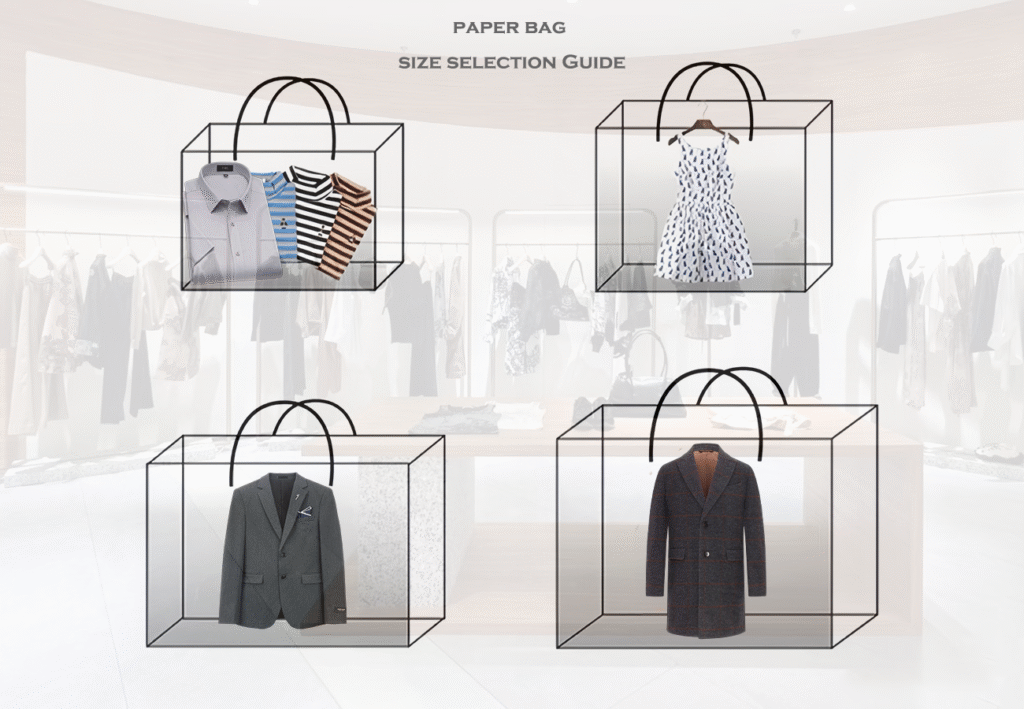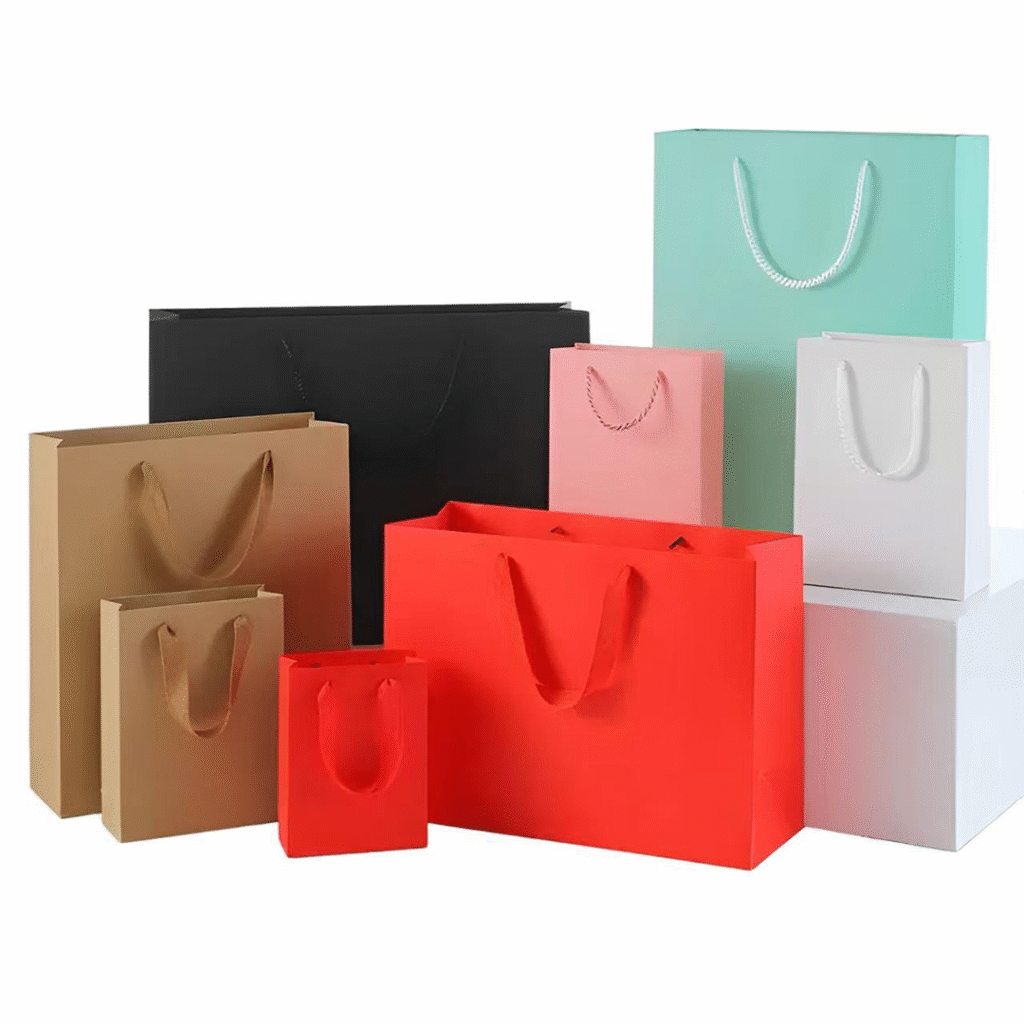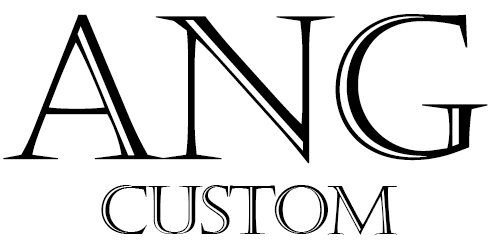Custom Paper Bag Sizes Guide: The Ultimate Guide to Choosing Perfect Dimensions for Clothing & Retail
Pick the wrong paper bag sizes for your clothes, and you’ll end up with two problems: either the bag is too big (wasting material and money) or too small (crushing clothes, making your brand look unprofessional). I’ve seen it happen—brands using 14×16-inch bags for folded shirts, just to have customers say, “It feels like I’m carrying an empty box.”
This guide isn’t about random numbers—it’s about matching sizes to what you sell and how your customers use the bags. Let’s break it down.

1. Why Size Matters More Than You Think
Before we get to numbers, let’s talk about the cost of getting it wrong:
Wasted Money: A bag that’s 2 inches too big uses 15% more paper—multiply that by 10,000 bags, and you’re throwing away budget.
Bad Customer Experience: A too-tight bag will crease a linen shirt or tear when someone tries to put a sweater in it. I had a boutique client switch sizes after 10 customers complained about damaged dresses.
Shipping Headaches: Oversized bags take up more space in boxes—meaning you’ll pay for extra shipping labels or bigger boxes.
2. Perfect Sizes for Common Fashion Items
These are the dimensions we recommend to most clients—they’re tested for fit and practicality:
Shirts, Blouses, or T-Shirts
Folded neatly, these need a bag that’s snug but not tight. Go with 10x12x4 inches (width x height x depth). Why? It fits a folded XL shirt without extra room, and the 4-inch depth stops the fabric from shifting around. Skip smaller sizes (like 9x11x3)—they’ll make customers struggle to fit the shirt.
Sweaters, Hoodies, or Jeans
Thicker items need more space. 12x14x5 inches works best. The extra 2 inches in height lets you fold a sweater in half (instead of cramming it) and the 5-inch depth handles jeans folded into thirds. I once had a streetwear brand use 11x13x4 for hoodies—half the bags tore at the seams. Upgrading to 12x14x5 fixed that.
Coats, Jackets, or Dresses
Bulky items need bigger bags, but don’t go overboard. 16x18x6 inches is ideal. It fits a folded lightweight coat or a knee-length dress without crushing the fabric. Avoid 18x20x7—they’re too big, and customers will have trouble carrying them (trust me, no one wants a bag that hits their knee).
Accessories (Scarves, Socks, or Jewelry)
Small items need small bags—8x10x3 inches is perfect. These double as cute Gift Bags too. A client who sells silk scarves uses this size, and customers often post photos of the bags on Instagram—they look “exquisite” (their words, not mine) without being tiny.

3. 3 Mistakes to Avoid When Choosing Sizes
Even with the right numbers, brands mess this up. Here’s what to skip:
Mistake 1: “One Size Fits All”
Don’t use the same bag for shirts and coats. A 16x18x6 bag for a t-shirt looks lazy—like you didn’t care enough to get the right fit.
Mistake 2: Forgetting Handles
If your bag has handles, add 2-3 inches to the height. A 10x12x4 bag with handles needs to be 10x15x4—otherwise, the handles will pull too tight when someone carries it, and the bag will start to tear.
Mistake 3: Ignoring Folding Style
Do you fold shirts in half or thirds? Folding in thirds makes the shirt wider—so you might need a 11x12x4 bag instead of 10x12x4. Test with your actual folding process, not just a “standard” fold.
4. When to Customize (Instead of Using Standard Sizes)
Sometimes standard sizes don’t work—like if you sell plus-size clothes or bulky winter jackets. Here’s when to ask for custom dimensions:
Your items are larger than XL (go up 1-2 inches in width/height).
You want a “slim” bag for narrow items (like dresses with thin straps—try 9x16x3 inches).
You’re using the bag for in-store displays (slimmer bags look neater on shelves).
Quick Recap
Choosing the right fashion paper bag sizes boils down to three things: match dimensions to your specific items (shirts = 10x12x4 inch, coats = 16x18x6 inch), avoid lazy mistakes like “one size fits all” or forgetting handle height, and always test samples with your actual folded clothes. Get it right, and you’ll cut waste, keep clothes in good shape, and make your brand feel more thoughtful to customers—win-win.
Need Expert Guidance?
ANG specializes in custom paper bag for global fashion brands. Contact us for a free consultation and material sample.
